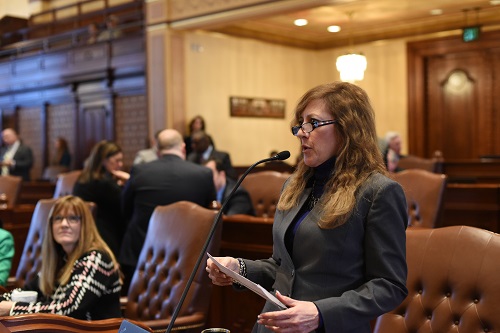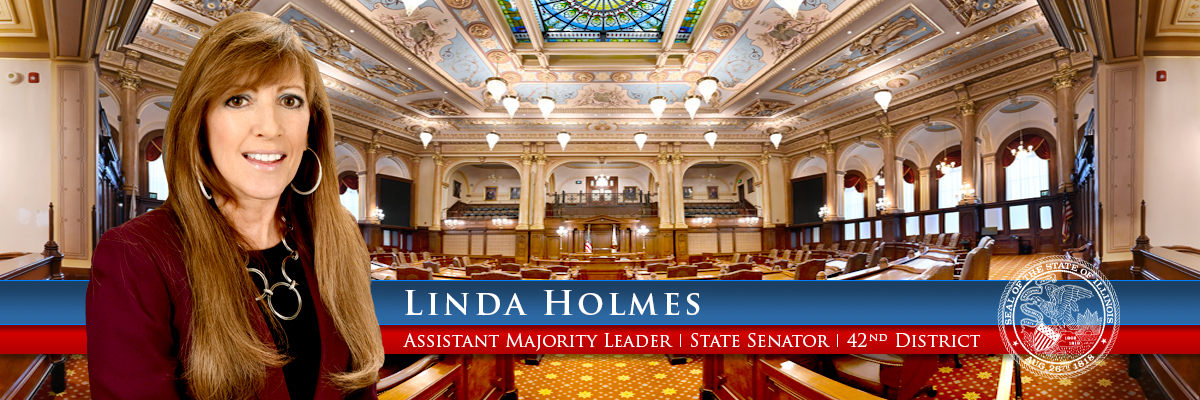
Senator Holmes joins Legislative Audit Commission
- Details
- Category: Latest
SPRINGFIELD – State Sen. Linda Holmes, D-Aurora, has joined the Illinois General Assembly’s commission to audit government activity.
“As a public servant, I have always sought to make our state’s government more transparent,” Holmes said. “On the Legislative Audit Commission, I get to work with Democrat and Republican colleagues from the Senate and the House to root out waste, fraud and abuse. I take this opportunity very seriously and I look forward to getting started.”
The Legislative Audit Commission is a bipartisan group of twelve legislators from the Illinois Senate and House of Representatives. The commission oversees audits of state agencies, holds public hearings and makes recommendations to the General Assembly on how to correct weaknesses.

Illinois rolls out ID cards to help people with disabilities
- Details
- Category: Uncategorised
SPRINGFIELD – Illinoisans with developmental, intellectual and mental disabilities can now apply for a special state ID card to help them navigate interactions with law enforcement thanks to legislation passed by Senator Linda Holmes (D-Aurora).
“The new ID cards give more information to law enforcement so that they don’t misinterpret certain behaviors as hostile or uncooperative,” Holmes said. “The cards will give people with disabilities and their loved ones peace of mind, knowing that their needs are being communicated to law enforcement. This idea was brought to our attention by a local parent whose child has autism, so the new ID cards are a response to an important demand from the community.”
In order to be issued a card, a person must have a disability such as autism, epilepsy, anxiety, bipolar disorder or schizophrenia. The cards can be given in addition to other state identification when requested by law enforcement.
“Fortunately, the Aurora Police Department and other law enforcement agencies in the 42nd district have already been proactive by training officers to have better interactions with people with disabilities,” Holmes said. “As more people begin to take advantage of these ID cards, first responders can develop and enrich their training programs.”
"This should be a great tool," Aurora police Lt. Mike Abbs said. "The more information we have on people's abilities and disabilities when we first encounter them, the better we can serve them."
The card lists identifying information and the following inscription: "My medical condition may impair my ability to communicate with others, especially with strangers or in stressful situations. Please do not interpret my behavior as refusal to cooperate."
Holmes urges area residents and their loved ones interested in being issued a person with a disability wallet card to apply for free at the Secretary of State’s office or contact her Aurora Office at (630) 801-8985.

Homes disappointed Rauner crew can't find cuts
- Details
- Category: News
SPRINGFIELD -- State Sen. Linda Holmes, D-Aurora, asked Illinois Department of Natural Resources Chief of Staff Brent Krebs why he and the department that he oversees remain optimistic about the passage of the grand bargain.
“You said that you are optimistic with the governor’s office and his budget people working on the grand bargain, which he has now blown up three or four times,” Holmes said. “With the governor’s budget being $4.6 billion out of balance, I want to know why you feel that this can be rectified without cuts to agencies such as yours, which have been pretty much decimated.”
Krebs responded that morale is still high in his department and that current budget woes have no effect on his optimism. “I maintain that an agreement can be reached,” Krebs said. “Without getting mired in the details of your negotiation, I’m convinced that we can get this thing done with some more negotiations.”
“I wish I shared your optimism,” Holmes said.
The bipartisan package of legislation known as the grand bargain was thrown off track last week when Gov. Rauner contacted Republican legislators and convinced them to vote against the package of interconnected proposals. Rauner’s move was a surprise to many, who pointed to the governor’s reliance on the framework’s revenue bills to close an almost $5 billion shortfall in his budget proposal and his public commentary praising the senate’s negotiations.
“I think you’re going to have to look at some cuts unless we get the governor to decide that he’s going to come up with revenue increases or even negotiate,” Holmes told Krebs. “At this point, Rome is burning. We need to do something.”

Holmes demands budget answers
- Details
- Category: Latest
SPRINGFIELD — In a senate hearing with Acting Director Anna Hui of the Illinois Department of Labor, State Sen. Linda Holmes, D-Aurora, asked what cuts could be made in the Department of Labor to balance the $4.6 billion out of balance budget.
“Being that the governor’s proposed budget was $4.6 billion out of whack and we’re now finding that that number might be more optimistic than it’s going to be, I would appreciate hearing from the department itself where you would be most willing to make those cuts,” Holmes said. “Where would you like to see those cuts if we are in a position where they have to be made?”
“We are not in the position to speculate about where those cuts might come from,” Hui said, to which Holmes replied: “Okay. Let’s call that nonresponsive.”
This week, Sen. Holmes and her fellow Democrats in the Senate have asked more than ten heads of state agencies what they would do should they be asked to cut their agencies’ budgets. In this year’s budget proposal, Gov. Rauner put forward a plan that spends $4.6 billion more than it collects in revenue. Rauner’s FY 18 budget proposal relies on the General Assembly to close this $4.6 billion gap by proposing new revenues or making cuts to programs.
“Gov. Rauner has been asking the General Assembly to give him the authority to make budget cuts for months. I would expect the governor’s agency heads to have some cuts already in mind,” Holmes said. “Clearly that is not the case.”
Director Hui is one of at least sixteen other state agency directors who have appeared before the Illinois Senate this week. None have suggested cuts to their departments’ budgets.
More Articles …
Page 71 of 84




